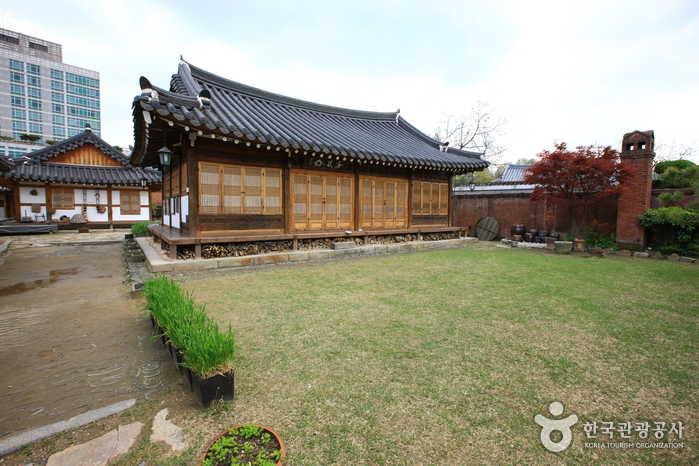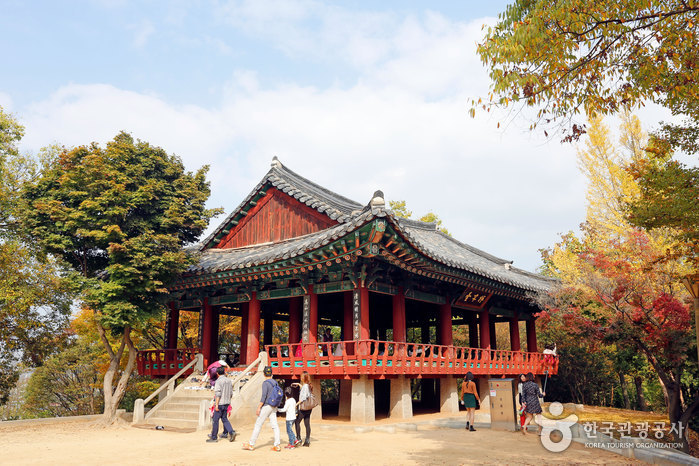Gyo Dong Sal Rae [Korea Quality] / 교동살래 [한국관광 품질인증]
499.0318068090283m 846 2024-04-07
66-1, Jeonjucheondong-ro, Wansan-gu, Jeonju-si, Région Jeonbuk
+82-10-9043-6743
Located at the entrance to Namcheongyo Bridge, which flows over Jeonjucheon Stream, Gyodongsalrae is a hanok structure built in 1971. It consists of the sarangchae (men’s quarters), anchae (women’s quarters), and byeolchae (detached House) and has ten guestrooms in total. While the sarangchae is situated near the road, the anchae and byeolchae are located to the rear of the house. Each building has a well-maintained flowerbed filled with seasonal flowers that harmonize perfectly with the beauty of the hanok.
The interior of the house is decorated with a variety of antiques, paintings, embroidery and knitting works, creating a cozy atmosphere. The ten rooms are of different sizes and styles including an ondol (Korean floor heating system) room, a room with a bed, and a darak (garret) room. The sarangchae consists of the Changpobang, Maehwabang, Baerongbang and Mokryeonbang rooms, of which the last two have a terrace with an open view. The anchae consists of a living room (sarangbang) and a room for two people. The byeolchae with a small courtyard has three large rooms with a capacity of four to six people and a separate space for relaxation and breakfast.
Dongnagwon (동락원)
513.8998584091408m 5946 2024-04-07
33-6, Eunhaeng-ro, Wansan-gu, Jeonju-si, Région Jeonbuk
+82-63-285-3490
La maison Dongnagwon est une bâtisse représentative du village de Hanok de Jeonju, offrant l’opportunité d’effectuer un ‘Hanok Stay’ (passer la nuit dans une maison traditionnelle coréenne) et de vivre la vie coréenne traditionnelle. Affiliée au collège Kijeon de Jeonju, Dongnagwo est aussi un lieu de commémoration à la mémoire de W. M. Junkin, venu en Corée en 1892 en tant que missionnaire, et originaire de l’église presbytérienne du sud des Etats-Unis. Dongnagwon est une structure hanok traditionnelle consistant en un Anchae (bâtiment principal), Sarangchae (maison détachée) et Haengnangcha (maison des domestiques). Elle représente parfaitement l’agencement des vieilles maisons hanok de Jeonju à l’époque où W. M. Junkin effectuait ses travaux religieux dans la région. Les visiteurs de Dongnagwon ont la possibilité de s’essayer à la vie traditionnelle coréenne en passant une nuit dans une chambre du hanok, mais également en découvrant la musique traditionnelle, l’artisanat local et la dance. De plus, Dongnagwon propose également l’hébergement de groupes ou l’accueil lors de l’organisation de conférences, séminaires et évènements familiaux. Pour les groupes supérieurs à 30 personnes, il est possible de louer le site entier (couvrant toutes les zones du site, incluant Seungdokdang, Seunghwadang, Cheongyuje, et le jardin de devant).
Pont Namcheongyo (남천교 청연루)
520.0424648626478m 21386 2024-04-24
40, Cheongyeong-ro, Wansan-gu, Jeonju-si, région Jeonbuk
Le pont Namcheongyo est le principal pont pour entrer dans le village des hanok de Jeonju. Avec le projet dénommé "Jeonju Namcheongyo Luxury Project", la zone a connu des rénovations pour renforcer la structure et ajouter le pavillon Cheongyeonru.
Les visiteurs peuvent apprécier une vue panoramique de la zone depuis le pavillon hanok ou se reposer à l'abri de la chaleur en été.
Dan Kyung [Korea Quality] / 단경 [한국관광 품질인증]
537.987593505433m 230 2024-04-07
99, Hanji-gil, Wansan-gu, Jeonju-si, Région Jeonbuk
+82-10-5304-4380
Beginning of brightness that is what Hanok Guesthouse Dankyung means. The name reflects the politeness and consideration of the people of Jeonju. It also carries the wish for the guests of the guesthouse to become polite and considerate as well.
Since it was built in June 1943, Dankyung has kept its original form intact through the turbulent period of Korea's liberation from Japanese colonization, Korean War, and modernization. Despite the traditional form, the approximately 70-year-old Hanok is convenient to use and is beautiful in shape, emitting its beauty and gracefulness to the visitors of Jeonju Hanok Village. Anyone staying in Dankyung will feel as if he/she has become a noble man/woman of old Korea.
The white birch garden at the entrance, maple tree, and apricot flower tree in the yard create a seasonal atmosphere. Dansil, Hyangsil, and Gyeongsil of the main building and Byeolsil and Dasil of the separate building are equipped with a wooden floor, giving off a delicate wood scent. The gallery opposite the garden displays artworks and provides a space for guests to have breakfast or drink coffee or tea. The rooftop of the gallery is a special place for guests so that they can enjoy an uninterrupted view of Jeonju Hanok Village over drinks.
Yedawon [Korea Quality] / 예다원 [한국관광 품질인증]
553.7249542215654m 184 2024-04-07
85-34, Hyanggyo-gil, Wansan-gu, Jeonju-si, Région Jeonbuk
+82-63-228-8218
Sitting at the foot of Omokdae, Yedawon is a classic Hanok opened in December 2013. It retains the unique beauty of Hanok, yet is equipped with neat and convenient facilities. The owner, who used to operate a traditional culture space for Hanok experience such as traditional tea and natural dying, newly built a Hanok for guests to be able to experience a cultural accommodation. Just one-minute away are Jeonjuhyangyo Confucian School and Jeonju Hanbyuk Culture Center, whereas the National Intangible Heritage Center is located over the Omokgyo Bridge outside the culture center. Gyenggijeon, Jeondong Catholic Cathedral, Omokgyo Bridge, and Nambu Market are all within walkable distance.
Yeodawon has six rooms named after flowers; ceilings with exposed rafters and crossbeams; walls with Hanji wallpapers; and decorations with black-and-white drawings and Korean calligraphy. In particular, Lotus Flower Room is furnished with a folding screen with a landscape painting on it, and a big black-and-white drawing.
Yeodawon is special in that guests can get first-hand experience of the traditional culture in different ways: traditional tea, traditional dying, Hanji, traditional dessert, traditional flower pancake, etc. The experience costs about 10,000 - 15,000 won per person, and available for four persons or more.
Ihwa Gotaek [Korea Quality] / 이화고택 [한국관광 품질인증/Korea Quality]
553.3066251652957m 11 2024-04-07
91, Hanji-gil, Wansan-gu, Jeonju-si, Région Jeonbuk
This “ㄱ”-shaped hanok (traditional Korean house) building, standing to the right-hand side of the gate, is an old house with a history of more than 120 years that was transplanted to its present site from its original location in Buan’s local Confucian school in Jeollabuk-do. The building to the left across the courtyard is a “ㄷ”-shaped building with a history of about 70 years. The buildings at Ihwa Gotaek stick to the classics of hanok architecture, featuring the trio of open wooden-floor spaces called numaru, toenmaru, and jjongmaru.
There are 8 rooms in total, 1 four-person room with eight maximum occupancy, and 7 two-person rooms with maximum occupancy of four. All rooms have their own attached restrooms. Guests are served with complimentary seasonal refreshments, either a sweet rice punch (sikhye) or shaved ice with sweetened red beans (pat bingsu) made in-house, and for breakfast guests have a wonderful spread that includes bibimbap, rice cake soup, black sesame porridge, and bean-powder-coated rice cake, served in traditional bronze tableware. Guests can also place their reservations for traditional cultural programs like pansori (epic chant), tea ceremony, natural dye, and Korean paper art, and enjoy a discount of 30% in hanbok (traditional Korean clothes) rental.
GaEunChae [Korea Quality] / 가은채 [한국관광 품질인증]
554.93633959372m 429 2024-04-07
68-13, Hanji-gil, Wansan-gu, Jeonju-si, Région Jeonbuk
+82-10-6345-5267
Gaeunchae is a Handol guesthouse located in Jeonju Hanok Village. Among the four Hanok buildings built by a construction company in 1969, two are being operated as a Gaeunchae guesthouse. While turning it into a lodging place, everything related to a private house was removed, but the original form of the building was revived for guests to feel the beauty of the traditional Hanok.
Jeonju Master's Crafts Center, Jeonju Korean Traditional Wine Museum, Seunggwangjae, Dakjongi Hanji Dolls Workshop, etc. are just a stone's throw away. In particular, the pretty alleys are part of the Hanok Village alley tour course 1 operated by Jeonju City.
In the middle of the yard of Gaeunchae are stones refined by hand years ago, including Macheon Stone, Sago Stone, Goheung Stone, Hwangdeung Stone, etc; the southern yard is paved with flat stones such as old granite, bakseok, and mica. Traditional room doors fitted without using any nails and traditional windows add to the gracefulness of Hanok.
Omokdae et Imokdae (오목대와 이목대)
556.5909344343419m 6058 2024-04-08
1-3, Gyodong 1-ga, Wansan-gu, Jeonju-si, Région Jeonbuk
+82-63-281-2114
Omokdae, situé en haut d'une colline est le lieu où Yi Seong-gye (qui devint plus tard le Roi Taejo) s'arreta pour célébrer sa victoire lors d'une bataille contre l'armée japonaise au Mont Hwangsan à Unbong vers la fin de la période Goryeo. C'est aussi là où Mokjo, l'un des ancêtres de Yi Seong-gye, vécut. Plus tard, le Roi Gojong y établit une statue monumentale, “Taejogohwang Jejupilyujibi” avec une phrase écrite de sa propre main. De l'autre côté de Yukgyo, à partir d'Omokdae, se trouve Yimokdae, au pied du Mont Seungamsan où Chimyeongjasan, sité sacré pour les catholiques demeure. A 80 m de Yimokdae se trouvent un mémorial et une maison. “Mokjodaewang Gugeoyuji”, la phrase gravée sur le monument en pierre, fut écrite par le Roi Gojong en personne. Mokjo est le cinquième ancêtre du Roi Taejo, qui fonda la Dynastie Joseon. Imokdae est connue pour être le lieu où Mokjo vécut, jouant à des jeux de formation de bataille avec ses amis étant enfant. Cette anecdote apparait également dans le Yongbieocheonga (ballade du 15e siècle narrant la longévité nationale et la réussite culturelle). Mokjo se rendit à Hamgyeong-do à partir d'Imokdae (à Jeonju) en raison de la querelle qu'il eut avec le Jeonju Busan (officiel de l'etat gouvernant la région de Jeonju). Yi Seong-gye pensa que le départ de Mokjo était quelque chose ayant été guidé par les dieux afin qu'il (Yi Seong-gye) puisse fonder Joseon et devenir le premier roi de la dynastie.
Bukyungdang [Korea Quality] / 부경당 [한국관광 품질인증]
557.5106684307216m 225 2024-04-07
99-5, Hanji-gil, Wansan-gu, Jeonju-si, Région Jeonbuk
+82-10-5327-8736
Located at the heart of the Jeongju Hanok Village, Bugyeongdang is a beautiful traditional 60-year old Hanok.
Traditional floor, roof tiles, and jar stands next to stone walls, while small garden and flower beds reflect the architect couple's attentive hands. As a Hanok with one of the prettiest gardens in Jeonju Hanok Village, it is a good place to appreciate the garden flowers and enjoy the unique laid-back atmosphere of Hanok while sitting on the floor. The place is close to major tourist attractions including Imokdae, Gyeonggijeon, Jeondong Catholic Cathedral, and Hyanggyo.
The owner, who was born and raised in the Jeonju Hanok Village, describes must-go sites like a tour guide and introduces undiscovered great restaurants or things-to-do to the guests. As the owner, who had long been engaged in architecture, takes care of the Hanok, the building always stays clean and in good condition.
In the shared kitchenette, guests can prepare simple breakfast for themselves with the dishes and cups made by the wife of the owner herself. Luggage storage services before check-in and after check-out, and description of tourist attractions are provided.
Musée de l'Alcool Traditionnel Coréen de Jeonju (전주 전통술박물관)
570.1654727260774m 5582 2024-04-07
74, , Wansan-gu, Jeonju-si, Région Jeonbuk
+82-63-287-6305
Découvrez la gloire de l’alcool traditionnel coréen dans ce musée ! Vous pouvez voir les outils et machines utilisés pour la fabrication, ainsi que des expositions sur le thème de l’alcool traditionnel. Les zones les plus intéressantes du musée sont considérées commé étant la salle de préparation d’alcool et la salle de fermentation. Grâce aux enceintes disposées dans ces deux salles, vous pourrez entendre les sons amplifiés que l’alcool émet pendant le procédé de fermentation. Vous pourrez également profiter des arômes séduisants de la liqueur traditionnelle coréenne. Les premiers et troisièmes samedis du mois, vous pourrez vous faire la main à la fabrication et pendant les seconds et quatrièmes, il vous sera possible de participer à une dégustation traditionnelle.
![Gyo Dong Sal Rae [Korea Quality] / 교동살래 [한국관광 품질인증]](http://tong.visitkorea.or.kr/cms/resource/71/2556371_image2_1.jpg)


![Dan Kyung [Korea Quality] / 단경 [한국관광 품질인증]](http://tong.visitkorea.or.kr/cms/resource/65/2593265_image2_1.jpg)
![Yedawon [Korea Quality] / 예다원 [한국관광 품질인증]](http://tong.visitkorea.or.kr/cms/resource/91/2594991_image2_1.jpg)
![Ihwa Gotaek [Korea Quality] / 이화고택 [한국관광 품질인증/Korea Quality]](http://tong.visitkorea.or.kr/cms/resource/50/2707550_image2_1.jpg)

![Bukyungdang [Korea Quality] / 부경당 [한국관광 품질인증]](http://tong.visitkorea.or.kr/cms/resource/29/2593529_image2_1.jpg)

 Français
Français
 한국어
한국어 English
English 日本語
日本語 中文(简体)
中文(简体) Deutsch
Deutsch Español
Español Русский
Русский